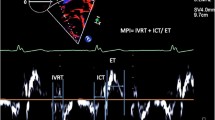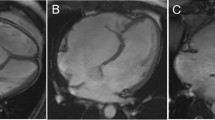Abstract
Objectives
We aimed to evaluate immediate and midterm cardiac remodeling after surgery by cardiac magnetic resonance (CMR) in Ebstein’s anomaly (EA), and also to investigate preoperative predictors of right ventricular (RV) normalization.
Methods
We retrospectively analyzed CMR parameters of the whole heart in adult patients with EA before surgery, at discharge and follow-up.
Results
A total of 26 patients were included and performed CMR at 7 days (interquartile range, 3–13 days) before surgery. Immediate postoperative CMR was finished at discharge (median: 8 [7–9] days; n = 18) and follow-up CMR at 187 days (interquartile range, 167–356 days; n = 17). RV and right atrial (RA) volumes promptly decreased immediately after surgery and at follow-up (all p < 0.05). RV ejection fraction decreased significantly at discharge (p < 0.05) but recovered at follow-up (p = 0.18). However, RV global longitudinal strain and RA reservoir strain were significantly impaired immediately and midterm after surgery (all p < 0.05). Indexed left ventricular (LV) end-diastolic volume, stroke volume, as well as global longitudinal strain increased from preoperative to follow-up (all p < 0.05). Patients who achieved normalization of RV volumes after surgery had smaller severity index and RV and RA volumes and higher LV ejection fraction and RA reservoir strain at baseline than patients without RV normalization (all p < 0.05).
Conclusions
Reverse biventricular remodeling took place in EA after tricuspid valve surgery. Tricuspid valve reconstruction should be performed before deterioration of RV volume overload and LV function to achieve reverse RV remodeling.
Key Points
• After removing the volume load of tricuspid regurgitation in Ebstein’s anomaly, reverse remodeling was detected by CMR in both left and right heart at midterm follow-up.
• Tricuspid valve reconstruction should be performed before deterioration of RV volume overload and LV function to achieve reverse RV remodeling.




Similar content being viewed by others
Abbreviations
- aRV:
-
Atrialized right ventricle
- CMR:
-
Cardiac magnetic resonance
- CMRs:
-
Cardiac magnetic resonance examinations
- GLS:
-
Global longitudinal strain
- IQR:
-
Interquartile range
- LA:
-
Left atria
- LV:
-
Left ventricular
- LVEDVi:
-
Indexed left ventricular end-diastolic volume
- LVSVi:
-
Indexed left ventricular stroke volume
- RA:
-
Right atria
- RV:
-
Right ventricle
- RVEDVi:
-
Indexed right ventricular end-diastolic volume
- RVEF:
-
Right ventricular ejection fraction
- RVESVi:
-
Indexed right ventricular end-systolic volume
- RVSVi:
-
Indexed right ventricular stroke volume
- SI:
-
Severity index
References
Attenhofer Jost CH, Connolly HM, Dearani JA, Edwards WD, Danielson GK (2007) Ebstein’s anomaly. Circulation 115(2):277–285
Celermajer DS, Bull C, Till JA et al (1994) Ebstein’s anomaly: presentation and outcome from fetus to adult. J Am Coll Cardiol 23(1):170–176
Qureshi MY, Sommer RJ, Cabalka AK (2019) Tricuspid valve imaging and intervention in pediatric and adult patients with congenital heart disease. JACC Cardiovasc Imaging 12(4):637–651
Freud LR, McElhinney DB, Kalish BT et al (2020) Risk factors for mortality and circulatory outcome among neonates prenatally diagnosed with Ebstein anomaly or tricuspid valve dysplasia: a multicenter study. J Am Heart Assoc 9(21):e016684
Schultz K, Haeffele CL (2020) Heart failure in the adult Ebstein patient. Heart Fail Rev 25(4):623–632
Attenhofer Jost CH, Tan NY, Hassan A et al (2018) Sudden death in patients with Ebstein anomaly. Eur Heart J 39(21):1970–1977a
Neijenhuis RML, Tsang VT, Marek J et al (2021) Cone reconstruction for Ebstein anomaly: late biventricular function and possible remodeling. J Thorac Cardiovasc Surg 161(3):1097–1108
Beroukhim RS, Jing L, Harrild D et al (2018) Impact of the cone operation on left ventricular size, function, and dyssynchrony in Ebstein anomaly: a cardiovascular magnetic resonance study. J Cardiovasc Magn Reson 20(1):32
Qureshi MY, O’Leary PW, Connolly HM (2018) Cardiac imaging in Ebstein anomaly. Trends Cardiovasc Med 28(6):403–409
Schulz-Menger J, Bluemke DA, Bremerich J et al (2020) Standardized image interpretation and post-processing in cardiovascular magnetic resonance - 2020 update: Society for Cardiovascular Magnetic Resonance (SCMR): Board of Trustees Task Force on Standardized Post-Processing. J Cardiovasc Magn Reson 22(1):19
Perdreau E, Tsang V, Hughes ML et al (2018) Change in biventricular function after cone reconstruction of Ebstein’s anomaly: an echocardiographic study. Eur Heart J Cardiovasc Imaging 19(7):808–815
Xu J, Yang W, Zhao S, Lu M (2022) State-of-the-art myocardial strain by CMR feature tracking: clinical applications and future perspectives. Eur Radiol 32(8):5424–5435
Monti CB, Secchi F, Capra D et al (2020) Right ventricular strain in repaired tetralogy of Fallot with regards to pulmonary valve replacement. Eur J Radiol 131:109235
Zachos P, Nevras V, Milaras N et al (2022) The value of myocardial strain imaging in the evaluation of patients with repaired tetralogy of Fallot: a review of the literature. Heart Fail Rev. https://doi.org/10.1007/s10741-022-10223-z
Petersen SE, Khanji MY, Plein S, Lancellotti P, Bucciarelli-Ducci C (2019) European Association of Cardiovascular Imaging expert consensus paper: a comprehensive review of cardiovascular magnetic resonance normal values of cardiac chamber size and aortic root in adults and recommendations for grading severity. Eur Heart J Cardiovasc Imaging 20(12):1321–1331
Ibrahim M, Tsang VT, Caruana M et al (2015) Cone reconstruction for Ebstein’s anomaly: patient outcomes, biventricular function, and cardiopulmonary exercise capacity. J Thorac Cardiovasc Surg 149(4):1144–1150
Lange R, Burri M, Eschenbach LK et al (2015) Da Silva’s cone repair for Ebstein’s anomaly: effect on right ventricular size and function. Eur J Cardiothorac Surg 48(2):316–320
Oosterhof T, van Straten A, Vliegen HW et al (2007) Preoperative thresholds for pulmonary valve replacement in patients with corrected tetralogy of Fallot using cardiovascular magnetic resonance. Circulation 116(5):545–551
Kim HK, Kim YJ, Park EA et al (2010) Assessment of haemodynamic effects of surgical correction for severe functional tricuspid regurgitation: cardiac magnetic resonance imaging study. Eur Heart J 31(12):1520–1528
Aly S, Seed M, Yoo SJ, Lam C, Grosse-Wortmann L (2021) Myocardial fibrosis in pediatric patients with Ebstein’s anomaly. Circ Cardiovasc Imaging 14(3):e011136
Yang D, Li X, Sun JY et al (2018) Cardiovascular magnetic resonance evidence of myocardial fibrosis and its clinical significance in adolescent and adult patients with Ebstein’s anomaly. J Cardiovasc Magn Reson 20(1):69
Bourfiss M, Vigneault DM, Aliyari Ghasebeh M et al (2017) Feature tracking CMR reveals abnormal strain in preclinical arrhythmogenic right ventricular dysplasia/cardiomyopathy: a multisoftware feasibility and clinical implementation study. J Cardiovasc Magn Reson 19(1):66
Zghaib T, Bourfiss M, van der Heijden JF et al (2018) Atrial dysfunction in arrhythmogenic right ventricular cardiomyopathy. Circ Cardiovasc Imaging 11(9):e007344
Funding
The study was funded by the National Key Research and Development Program of China (2021YFF0501404, 2021YFF0501400) and National Natural Science Foundation of China (No. 81930044).
Author information
Authors and Affiliations
Corresponding author
Ethics declarations
Guarantor
The scientific guarantor of this publication is Shihua Zhao.
Conflict of interest
The authors of this manuscript declare no relationships with any companies, whose products or services may be related to the subject matter of the article.
Statistics and biometry
No complex statistical methods were necessary for this paper.
Informed consent
Written informed consent was waived by the institutional review board.
Ethical approval
Institutional review board approval was obtained.
Methodology
• retrospective
• performed at one institution
Additional information
Publisher’s note
Springer Nature remains neutral with regard to jurisdictional claims in published maps and institutional affiliations.
Rights and permissions
Springer Nature or its licensor (e.g. a society or other partner) holds exclusive rights to this article under a publishing agreement with the author(s) or other rightsholder(s); author self-archiving of the accepted manuscript version of this article is solely governed by the terms of such publishing agreement and applicable law.
About this article
Cite this article
Yu, S., Yang, K., Chen, X. et al. Cardiac remodeling after tricuspid valve repair in Ebstein’s anomaly: a magnetic resonance study. Eur Radiol 33, 2052–2061 (2023). https://doi.org/10.1007/s00330-022-09190-8
Received:
Revised:
Accepted:
Published:
Issue Date:
DOI: https://doi.org/10.1007/s00330-022-09190-8




